
views
- Look for lymph nodes in your head, neck, armpit, and groin. Use 3 fingers to gently rub the area and feel for the lymph nodes.
- If the lymph nodes feel hard and enlarged, they’re likely swollen. If they feel soft and pea-sized, they are normal and not swollen.
- Check your swollen lymph nodes daily, and go to the doctor if they are swollen for more than 1 week. Swollen lymph nodes could indicate an underlying infection.
Feeling For Swollen Lymph Nodes
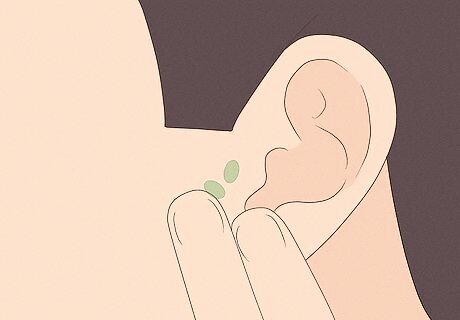
Rub the lymph nodes in front of your ear. The lymph nodes in your head and neck are the easiest to find, especially if you don’t have any medical training. Use 2 or 3 fingers to gently rub the area in front of your ears, just above your jaw. You’ll feel 2 small nodes in front of each ear. If you can’t feel anything at all, that’s okay. It likely means your lymph nodes are not swollen. Press gently and move your fingers slowly to feel for lumps under the skin. Lymph nodes are typically present in groups, and are about the size of a pea or bean. Healthy lymph nodes should feel more rubbery and pliable than the surrounding tissue but not hard as a rock.
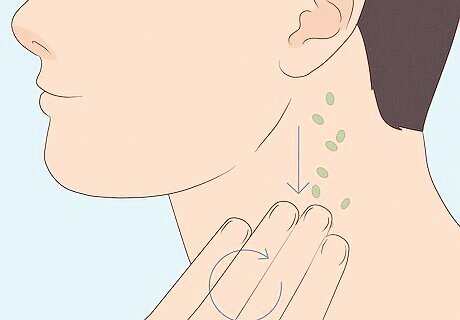
Check the lymph nodes in your neck. Bring your hands down directly underneath your jawline on either side of your throat. Slowly move your fingers in circular motions to feel for the lymph nodes in your neck. If you can't feel the lymph nodes in your neck, lean your head towards the side you are having trouble checking. This will relax the muscles and allow you to feel the lymph nodes more easily.
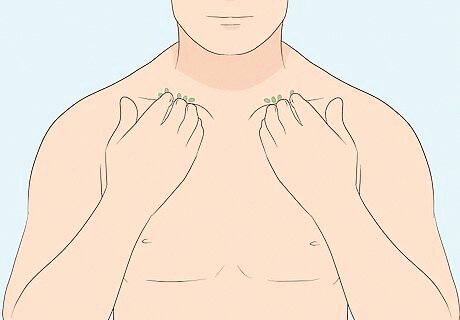
Hunch your shoulders and feel for the lymph nodes above your collarbone. There is a cluster of lymph nodes directly above each collarbone. To make them easier to feel, hunch your shoulders forward and bring your elbows in front of your body. Then, press your fingers just above your collarbone to feel the lymph nodes. The lymph nodes are in the center of each collarbone.
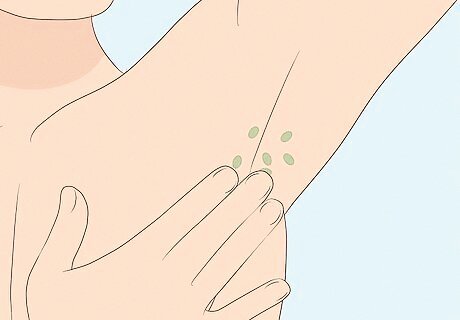
Feel the lymph nodes in your armpits. Place your first 3 fingers in the center of your armpit. Then slide them slowly down your torso a few inches until they are just above the side of your chest. The lymph nodes in this area are located toward the bottom of your armpit, near the rib cage. Run your fingers all around this area with gentle pressure. Move them towards the front of the body, the back of the body, and up and down a few inches. Wear a thin T-shirt or nothing at all to make these lymph nodes easier to feel.
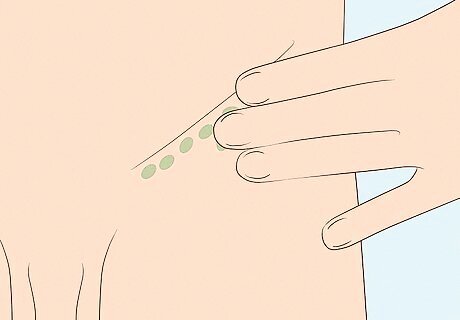
Feel for the inguinal lymph nodes in your groin. Move your first 3 fingers to the crease where your thigh meets your pelvis. Press your fingers into the crease with moderate pressure and you should feel the muscle, bone, and fat beneath. If you feel a distinct lump in this area, it may be a swollen lymph node. The nodes in this area are typically right below a large ligament, so they can be hard to feel unless they are swollen. Be sure to feel both sides of the groin. This will allow you to compare how they feel and to identify if one side of lymph nodes is swollen.
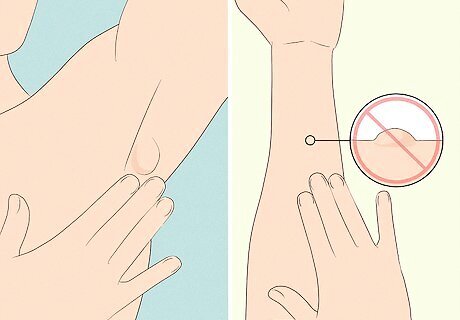
Check for a lump and tenderness to indicate a swollen lymph node. Take your fingers and press on an area of your body that doesn’t have lymph nodes, like your forearm. Now, compare it to an area that does have lymph nodes. Do you feel a difference from how it felt when you pressed your forearm? You should feel the bones and muscles underneath the skin, but a swollen lymph node will feel different and almost out of place. If you feel a lump accompanied by tenderness, you may have a swollen lymph node. Most swollen lymph nodes go away on their own within a few days. You can reduce swollen lymph nodes by using a warm compress and taking an OTC medication, like ibuprofen. If your lymph nodes are pea-sized or bean-sized, they are not swollen.
Having a Doctor Check Your Lymph Nodes

See a doctor if your lymph nodes are swollen for longer than 1 week. Sometimes lymph nodes swell in reaction to an allergy or a short-lived infection caused by a bacteria or a virus. If that's the case, they'll usually return to normal within a few days. However, if your lymph nodes remain swollen, hard, or sore for more than 7 days, it's important to see a doctor to determine the cause. Typical causes of swollen lymph nodes include: The common cold, which can be treated at home with rest and OTC pain medicine. Strep throat, which can be treated with prescription antibiotics. Lupus, which must be treated by a doctor using prescription medication. Arthritis, which can be managed at home using pain medication and self care.
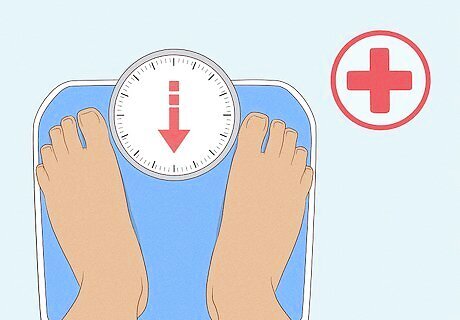
See a doctor right away if you experience symptoms of a serious illness. Swollen lymph nodes could be a sign that your body's immune system is fighting off a serious illness. If you experience swollen lymph nodes in conjunction with any of these symptoms, see a doctor right away: Unexplained weight loss Night sweats Persistent fever Trouble swallowing or breathing
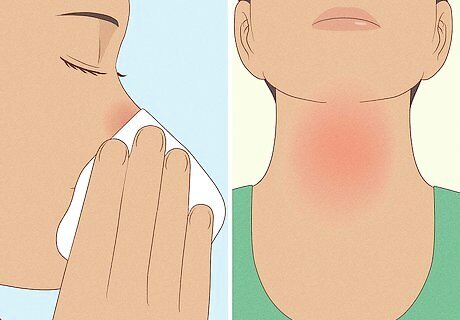
Tell your doctor if any other symptoms are present. While not all symptoms signal a serious illness, letting your doctor know about all of your symptoms will help them diagnose you. Some common symptoms that that often show up alongside swollen lymph nodes include: Runny nose Fever Sore throat Swelling of several lymph node areas at the same time

Check whether or not the swelling is due to an infection. If you come into your doctor's office with swollen lymph nodes, your doctor will feel the nodes to ensure they are swollen. Then they will need to test you for bacterial and viral infections that could be causing the swelling, either by testing your blood or taking a culture from an area of your body, such as your throat. It's likely you will be tested for the most common illnesses that cause lymph nodes to swell, including common viruses like strep throat.
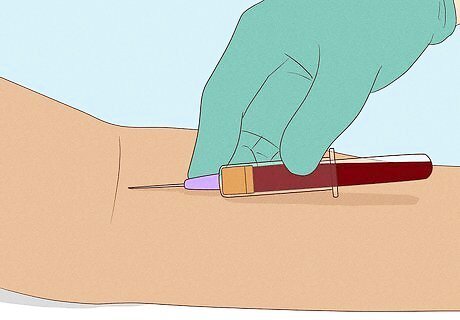
Get testing done for immune system diseases. Your doctor will likely assess the health of your immune system overall. The doctor could order a variety of tests, including a general blood analysis, which will gauge your immune system's activity. This will help them determine whether you have an immune system disease, such as lupus or arthritis, that is causing the lymph nodes to swell. Diagnostic tests will allow the doctor to assess how your immune system is functioning, such as whether you have a low blood count, and whether there is anything abnormal going on in the lymph nodes themselves.

Have testing done for cancer if everything else is ruled out. In some rare cases, swollen lymph nodes can be a symptom of cancer in the lymph nodes themselves or in other parts of the body. Preliminary tests used to identify cancer can include a blood panel, an X-ray, a mammogram, an ultrasound, or a CT scan. Once cancer is suspected, your doctor may suggest doing a biopsy of the lymph node to look for cancer cells. A lymph node biopsy is usually an outpatient procedure, but it does require an incision or deep needle puncture to get a sample of your lymph node cells. Which test the doctor chooses depends on what lymph nodes they are testing and what they suspect might be the problem.



















Comments
0 comment